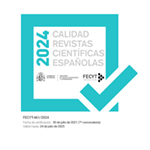Die Klassifizierung in ,Philologische Kategorien‘ der im Coranus Graecus überlieferten Koranfragmente. Eine Einteilung in Wörtliches Zitat, Freies Zitat, Paraphrase und Anspielung
Resumen
Der Artikel schlägt ein einheitliches System für die Kategorisierung von aus dem Arabischen in eine andere Sprache übersetzten Koranpassagen vor. Die Einteilung in vier sogenannte ,Philologische Kategorien‘ basiert auf Kriterien, die die sprachliche Beziehung zwischen der Ausgangs- und der Zielsprache in Bezug auf die dort verwendete Grammatik, Syntax und Semantik widerspiegeln. Die Kategorisierung stützt sich auf einen früheren Forschungsansatz, der durch die Definition von vier Kategorien weiterentwickelt wurde: Wörtliches Zitat, Freies Zitat, Paraphrase und Anspielung. Zunächst werden Definitionen für jede ,Philologische Kategorie‘ gegeben (Abschnitt 2). Das System der Kategorisierung wird dann anhand der griechischen Koranübersetzung Coranus Graecus (9. Jh. terminus ante quem), die in die Zeit der griechisch-arabischen Übersetzungsbewegung zurückreicht, exemplifiziert (Abschnitt 3). Zur Veranschaulichung der vorgeschlagenen Systematisierung werden mehrere Fallbeispiele angeführt und Grenzfälle kritisch diskutiert (Abschnitt 3.1–4). Die Analyse zielt einerseits auf eine vertiefte vergleichende Untersuchung der griechischen und arabischen Philologien ab, um andererseits einen methodischen Gesamtansatz zur Diskussion zu stellen, wie Koranübersetzungen philologisch klassifiziert und somit miteinander vergleichbar gemacht werden können. Ein theoretischer Rahmen, der den philologischen Kontext der übersetzten Passagen berücksichtigt, wird eine angemessenere und kontextbezogene Interpretation von Texten aus der Zeit der Graeco-Arabica gewährleisten. Der Artikel hat zum Ziel, eine weiterführende Diskussion darüber anstoßen, wie die philologische Beziehung zwischen griechischen und arabischen Textpassagen in einer einheitlichen Weise systematisiert werden könnte, um so mehr quellenbasierte Schlussfolgerungen zu ermöglichen.











